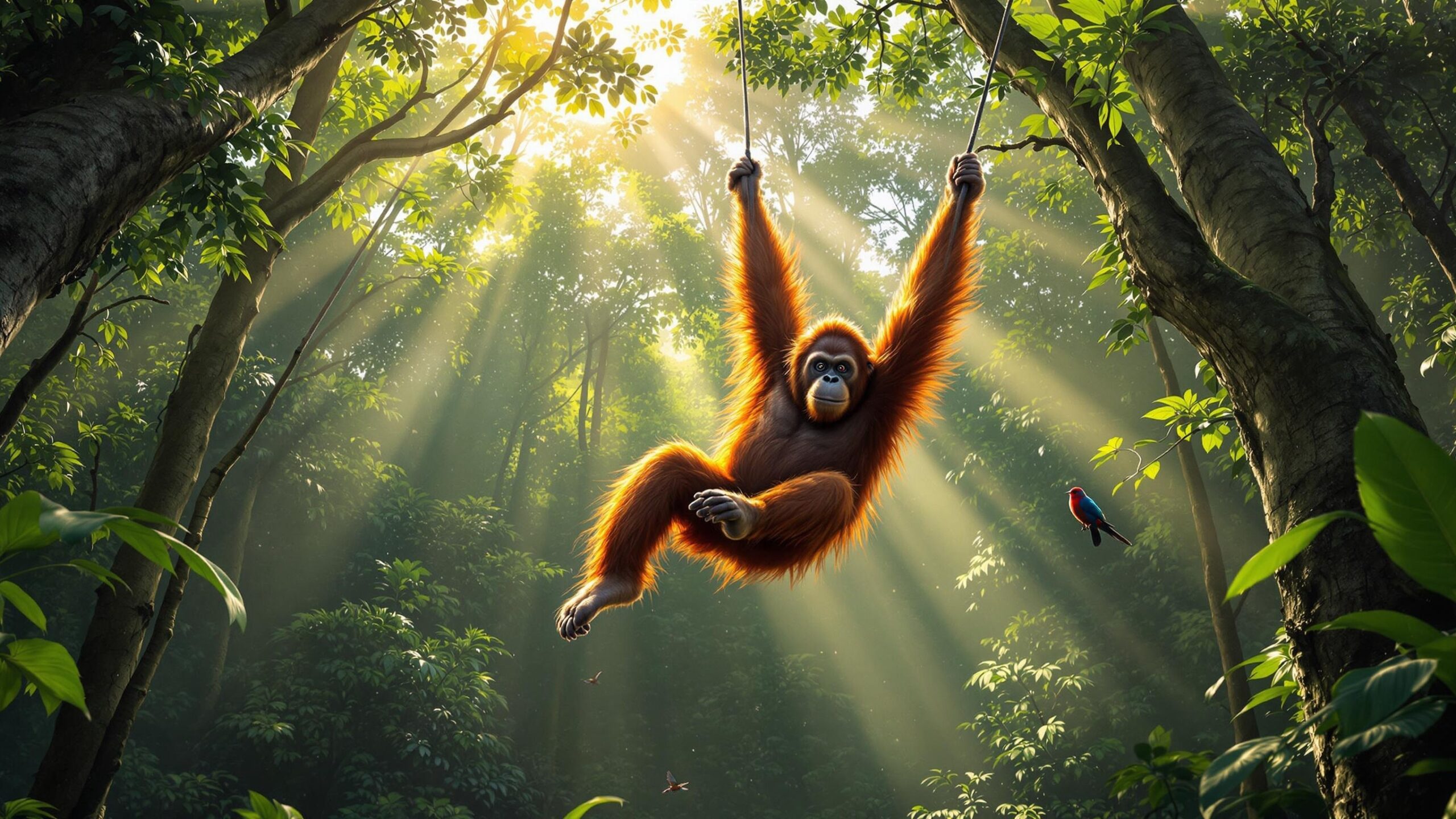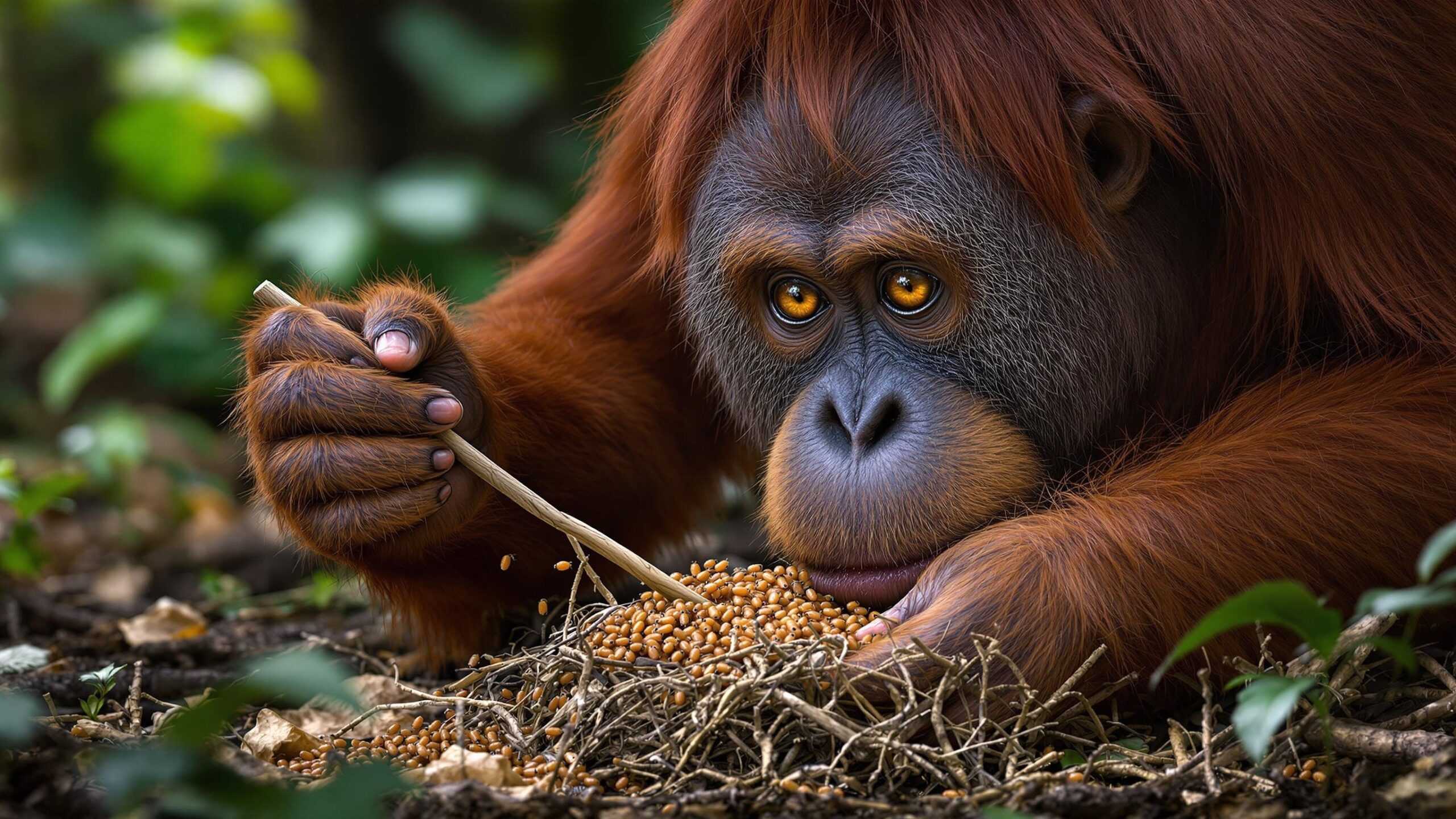Sumatran Orangutan: The Endangered Gentle Forest Dweller
The Sumatran orangutan (Pongo abelii) is one of the world’s most iconic and intelligent primates, known for its deep auburn fur, remarkable arboreal agility, and complex social behaviors. Native to the dense tropical rainforests of Sumatra, Indonesia, this critically endangered species is not just a biological marvel but also a vital player in its ecosystem. From its expressive face to its thoughtful demeanor, the Sumatran orangutan offers a window into the wild, revealing the intricate balance of life in Southeast Asia’s fast-disappearing jungles.
A Primate Apart: Understanding the Sumatran Orangutan
Belonging to the great ape family, the Sumatran orangutan is one of three extant orangutan species, the others being the Bornean (Pongo pygmaeus) and the recently identified Tapanuli (Pongo tapanuliensis). The Sumatran species is distinct in both appearance and behavior. Slightly smaller and more slender than its Bornean cousin, the Sumatran orangutan has a longer face, lighter hair, and longer limbs, making it particularly suited to a life spent almost entirely in the trees. These apes are largely solitary, with males and females coming together only for brief mating periods. Mothers are the cornerstone of orangutan society, raising their young in close-knit, long-lasting bonds that often last up to 8 years—the longest dependency period of any non-human mammal.
Lifespan, Size, and Physical Traits
Sumatran orangutans can live up to 40–50 years in the wild, and longer in captivity. Adult males typically weigh between 90 and 200 pounds and can reach over 4.5 feet in height when standing. Females are considerably smaller, usually weighing around 65 to 110 pounds. Their impressive arm span, which can reach up to 7 feet, helps them swing with ease from branch to branch, a method of locomotion known as “brachiation.” Mature males often develop large cheek pads called flanges, which are composed of fatty tissue and serve as both a visual signal to females and an auditory amplifier for their long-distance calls, known as “long calls.” These calls can echo for miles through the forest canopy, warning rival males and attracting potential mates.
Rainforest Royalty: Natural Habitat
The Sumatran orangutan is found only on the island of Sumatra in Indonesia, primarily in the northern province of Aceh. The species thrives in lowland and montane rainforests, especially in the Leuser Ecosystem, one of Southeast Asia’s last great tracts of intact tropical rainforest. Their preferred habitat includes dense canopies, towering trees, and abundant fruiting plants. Orangutans are arboreal specialists, spending over 95% of their lives in the trees. They rarely descend to the ground, partly due to the presence of terrestrial predators like the Sumatran tiger.
What’s on the Menu? Diet and Foraging Habits
Sumatran orangutans are frugivores, meaning fruit makes up the majority of their diet. Figs, durians, lychees, and jackfruit are among their favorites. They also consume leaves, bark, flowers, termites, ants, and occasionally bird eggs. Their diet is not only diverse but also varies with the seasons and food availability. Orangutans are known for their impressive cognitive skills, using sticks to extract insects or to pry open fruit. Their dietary habits play a crucial ecological role—by consuming fruit and dispersing seeds, orangutans help maintain the forest’s biodiversity and health.

Intelligence and Tool Use
Among the most intelligent non-human animals, orangutans exhibit advanced problem-solving abilities, self-awareness, and tool use. Wild Sumatran orangutans have been observed crafting tools from sticks to fish termites out of their mounds or to extract honey from beehives. Some have even been seen using leaves as makeshift umbrellas or as gloves to handle thorny plants. Their intelligence also manifests in their ability to plan and remember the locations of fruiting trees, a skill that reflects both memory and foresight. In captivity, orangutans have demonstrated the ability to learn sign language, solve puzzles, and use touchscreens.
Reproduction and Parental Care
The reproductive cycle of the Sumatran orangutan is one of the slowest among mammals. Females give birth approximately every 8 to 9 years, typically to a single infant. This slow reproductive rate is a major factor in the species’ vulnerability to extinction. After birth, the infant clings to its mother almost constantly for the first few months and remains dependent on her for food, safety, and learning survival skills for many years. During this extended period, the young learn how to find food, build sleeping nests, and avoid dangers—skills critical to survival in the wild.
Communication and Social Structure
Despite their largely solitary nature, Sumatran orangutans communicate through a rich repertoire of vocalizations, facial expressions, and body language. In addition to the loud, resonant long calls of adult males, orangutans produce softer grunts, squeaks, and kisses to convey a range of emotions and intentions. Females with dependent offspring often form loose associations with other mothers, creating temporary social units. These gatherings provide social enrichment for young orangutans and opportunities for play, which is essential for cognitive development.
Threats in the Wild
The primary threats to the Sumatran orangutan are habitat loss, illegal logging, palm oil plantations, and poaching. Sumatra’s rainforests are among the most threatened on Earth, with vast areas being cleared for agricultural use—especially for palm oil, which is found in many everyday products from shampoo to snack foods. Human-wildlife conflict also poses a significant threat. Orangutans are sometimes killed or captured when they wander into plantations in search of food. Infants are also illegally taken for the pet trade, often resulting in the death of the protective mother.
Conservation Efforts and Hope for the Future
Despite the grim statistics, concerted conservation efforts are providing hope for the Sumatran orangutan. Organizations like the Sumatran Orangutan Conservation Programme (SOCP) and the Orangutan Information Centre (OIC) are working tirelessly to rescue, rehabilitate, and reintroduce orangutans into the wild.
Legal protection, community education, forest restoration, and sustainable development initiatives are all vital components of conservation strategies. In 2016, Indonesia established a moratorium on new palm oil plantation permits, offering a ray of hope for the future of its forests and wildlife. Eco-tourism has also emerged as a valuable conservation tool, raising awareness and generating revenue to support habitat protection. Responsible tourism initiatives allow people to observe orangutans in their natural habitat without disrupting their behavior, fostering a deeper appreciation for these incredible apes.
The Role of Zoos and Captive Programs
Zoos around the world play a crucial role in orangutan conservation through education, research, and breeding programs. Modern zoos adhere to strict ethical and welfare standards, creating enriched environments that stimulate the apes’ minds and encourage natural behaviors. Captive breeding programs, while controversial to some, serve as an insurance policy against total extinction. They also provide opportunities for research that can inform conservation strategies in the wild.
Cultural Significance and Human Connection
In local folklore and traditional stories, orangutans are often portrayed as forest spirits or “people of the forest,” a reference to their human-like appearance and behaviors. This deep-rooted connection has inspired both reverence and fear, influencing how communities perceive and interact with them. Modern media has further elevated the orangutan to a symbol of environmentalism. From documentaries to global campaigns, the Sumatran orangutan has become an ambassador for rainforest conservation and a poignant reminder of what is at stake in the fight against deforestation.

Why the Sumatran Orangutan Matters
The survival of the Sumatran orangutan is about more than just saving a single species. It’s about preserving the integrity of an entire ecosystem. These apes are keystone species—organisms that have a disproportionately large impact on their environment relative to their abundance. Without them, the health and diversity of the rainforest would decline, affecting countless other species, including humans. Protecting orangutans helps safeguard biodiversity, combat climate change, and maintain vital ecological processes like seed dispersal and nutrient cycling. In essence, saving the orangutan helps save the forest.
How You Can Help
Even if you live thousands of miles away from Sumatra, your actions can make a difference. Supporting organizations that protect orangutans, choosing sustainably sourced products (especially those without palm oil or with certified sustainable palm oil), and spreading awareness are meaningful steps toward conservation. Simple choices—like checking labels, reducing paper waste, and donating to trusted conservation groups—can collectively have a massive impact. Education and awareness are key, especially among younger generations who will carry the torch of conservation into the future.
Reflection
The Sumatran orangutan is a gentle giant of the treetops, a creature of remarkable intelligence, resilience, and grace. Yet, its future hangs in the balance. As we marvel at the complexity of its social life, the ingenuity of its foraging, and the nurturing bond between mother and infant, we are reminded of the deep interconnectedness of all life. Preserving the Sumatran orangutan is not just an act of environmental stewardship—it is a moral imperative. In safeguarding their world, we safeguard our own, ensuring that future generations can look up into the canopy and catch a glimpse of red fur swinging through the green, a symbol of wild wonder and a thriving planet.

